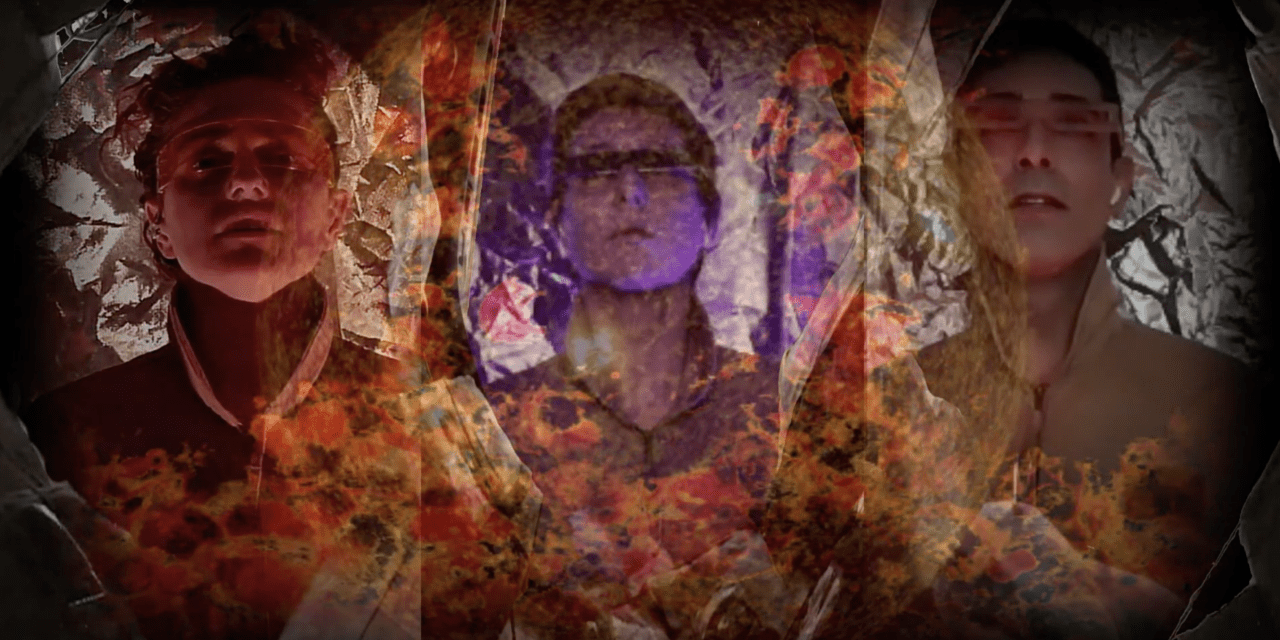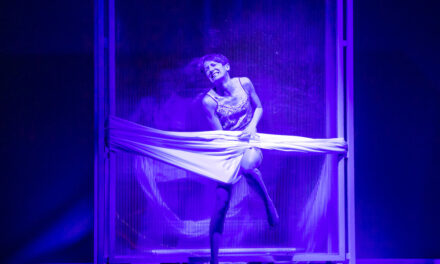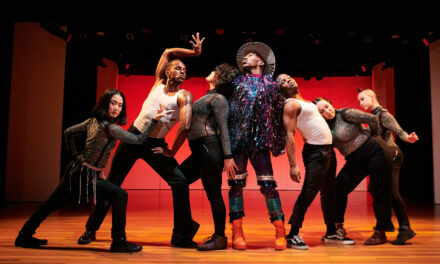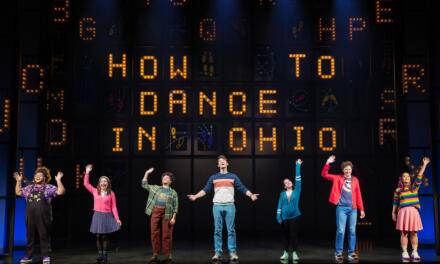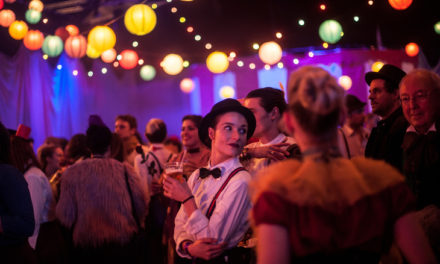Red Giant, commissioned by Baltimore-based Indie Opera company, Rhymes with Opera, is a live, digital sci-fi opera directed by Ashley Tata. The music of the opera was composed by Adam Matlock and the libretto was written by Brian Slattery. First staged in 2013, Red Giant is newly reimagined in this forty-minute digital production which was available on-demand till 6 July.
The narrative focuses on three characters who have just woken up from hibernation after their escape from the earth as the dying sun (the “Red Giant”) has engulfed the planet in flames. As they confine themselves in a spaceship, isolated in their respective pods, the trio voice their shared fears and hopes towards an unknown future and destination that awaits them.
Initially conceived as a pure fantasy just a decade ago when the opera was written, the present digital revival of Red Giant is hauntingly reflective of the times that we are going through today. The timeliness of the subject matter is sure to resonate with all of us who are experiencing a post-apocalyptic era that is further escalated by the ongoing climate crisis.
New Storytelling Formats in Opera
Since the onset of the pandemic, many Indie Opera companies have come up with innovative storytelling presentations, such as Zoom operas (HERE Arts Center’s All Decisions Will Be Made by Consensus, Only You Will Recognize the Signal), digital operas (White Snake Project’s Death by Life, Alice in the Pandemic), and opera films (Boston Lyric Opera’s desert in, The Fall of the House of Usher). These creative performances and productions deploy various media platforms as a live media server, in a way standing in as both the site and sight of the performance.
Red Giant is participating in this converging trend of technology and opera, which made the performance possible in the first place. As it turns out, the three singers were performing synchronously from three different cities, with soprano Bonnie Lander in Baltimore, soprano Elisabeth Halliday-Quan in Rochester, and baritone Robert Maril in New York.
Claustrophobic Stuckness
An ominous sense of claustrophobia haunts the opera for the most part, contributed by the oscillating motifs reappearing throughout that convey an unending sense of stuckness, the static visual presentation of protagonists confined in their respective pods, and the retro filters evoking the surrealist color palettes of David Lynch. We, while empathizing with the entrapped characters, are also reminded of our own seclusion from the rest of the world.
Right from the opening, we are tossed into the uncanny realm of outer space as the strings sound their jittery tremolos accompanied by static piano chords and dark shrouding cymbals looming in the background. The first voice we hear is not operatic singing, but the guttural vocalizations of “ahh” by the three protagonists donned with cyberpunk goggles, as they appear separately enclosed in their respective pods. This animate set of futuristic sci-fi visual vocabulary is effectively realized through retro-tinted filters.
Audiovisual Aesthetics
Next, we are treated to a captivating visual experimentation as the director delivers a quasi-music video aesthetic in the transition scene. The sound and image get fused into a single sensory phenomenon as we observe the image of the sterile interiors of a spaceship being overlaid against the dark backdrop of the mysterious outer space, with subtle manipulations of lighting that sensitively reacts to the shifts in the rhythm and dynamic intensity of the music. This audiovisual aesthetic gestures to some sort of a tantalizing elsewhere, turning our attention to the sounds that affect and shape our experience of the unfolding visual events.
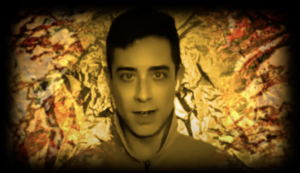
Photo credit: Ashley Tata. Protagonist 1 seen through a retro yellow-tinted filter.
In the first scene of the opera, protagonists 1 and 2 who have just woken up from their long hibernation, are quibbling over whether to turn on the lights. While protagonist 2 wants the lights on to get a sense of where they are headed to, protagonist 1 is opposed to it as he is afraid that the spaceship will run out of power in the midst of their journey. Then, he starts engaging in a moving reminiscence of the past when humans used to revel in the sun.
The use of a yellow-orange tinted filter here in accompanying protagonist 1’s moving aria is not only telling of the past, but more specifically, his remembrance of the past delivered in the poignant lines, “Did everyone know it was the last day, then? And did they stay out, until the sun was gone? Because there was never a day like it again.” Strikingly, the dramaturgic use of yellow-orange tinting further evokes the nostalgic sepia tones that dominate silent films of the 1920s, visually inscribing a sort of temporal apartness from the futuristic setting of the opera. A past that one can no longer return to.
Existential Questioning
This nostalgic revelry is rudely interrupted by protagonist 3 who is jolted awake by the glaring lights. The three characters continue bickering with one another, before once again falling into a perpetual cycle of existential speculations that reveal their anxieties, doubts, and hopes for an uncertain future looming ahead of them. In outer space.
Let’s have a look at their conversation below:
3: A little bit, yes. We’re all that’s left now. When we get somewhere we can start over—
2: When? I think it’s more an if than when.
1: If you thought that, then why are you here?
2: Because I want every second I can get.
3: You don’t want to start over?
2: It’s not a question of what I want. It’s a question of what I can have.
3: You have to hope that this—where we are now—isn’t all we’re going to have.
2: I don’t hope for anything.
1: So it’s worse than I thought.
Aren’t these existential questions the exact same ones we’ve been asking ourselves everyday since the start of the pandemic?
Radio Voice
After the conversation, the trio resumed their own mundane activities. Then, we hear the white noise of the radio signal brought to the fore, with orchestral music sounding in the background. The radio voice announces that they were right below the surface of the fourth planet orbiting around the sun, and that sun was about to explode, hence implying that not long after they reach the planet, they will have to flee again.
This gloomy news sets off a fresh wave of panic among them, before the radio voice re-enters, repeating his final words, “Goodbye, everyone. Goodbye. I love you all. And if I’m still here tomorrow, I’ll say the same thing.” The opera descends into yet again a dystopic time loop of eternal entrapment as the protagonists stare into the abyss of an unknown future.
At the end, we are shown the same image of the “red giant” that opens the opera.
This post was written by the author in their personal capacity.The opinions expressed in this article are the author’s own and do not reflect the view of The Theatre Times, their staff or collaborators.
This post was written by Jingyi Zhang.
The views expressed here belong to the author and do not necessarily reflect our views and opinions.

